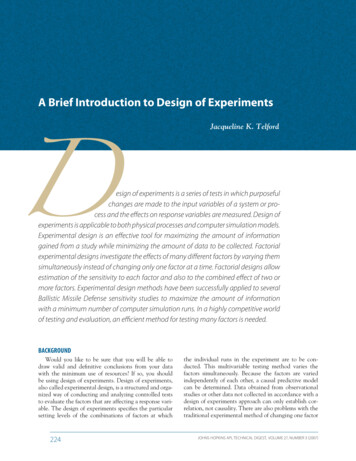
Transcription
J. K. TELFORDDA Brief Introduction to Design of ExperimentsJacqueline K. Telfordesign of experiments is a series of tests in which purposefulchanges are made to the input variables of a system or process and the effects on response variables are measured. Design ofexperiments is applicable to both physical processes and computer simulation models.Experimental design is an effective tool for maximizing the amount of informationgained from a study while minimizing the amount of data to be collected. Factorialexperimental designs investigate the effects of many different factors by varying themsimultaneously instead of changing only one factor at a time. Factorial designs allowestimation of the sensitivity to each factor and also to the combined effect of two ormore factors. Experimental design methods have been successfully applied to severalBallistic Missile Defense sensitivity studies to maximize the amount of informationwith a minimum number of computer simulation runs. In a highly competitive worldof testing and evaluation, an efficient method for testing many factors is needed.BACKGROUNDWould you like to be sure that you will be able todraw valid and definitive conclusions from your datawith the minimum use of resources? If so, you shouldbe using design of experiments. Design of experiments,also called experimental design, is a structured and organized way of conducting and analyzing controlled teststo evaluate the factors that are affecting a response variable. The design of experiments specifies the particularsetting levels of the combinations of factors at which224the individual runs in the experiment are to be conducted. This multivariable testing method varies thefactors simultaneously. Because the factors are variedindependently of each other, a causal predictive modelcan be determined. Data obtained from observationalstudies or other data not collected in accordance with adesign of experiments approach can only establish correlation, not causality. There are also problems with thetraditional experimental method of changing one factorJohns Hopkins APL Technical Digest, Volume 27, Number 3 (2007)
A BRIEF INTRODUCTION TO DESIGN OF EXPERIMENTSat a time, i.e., its inefficiency and its inability to determine effects that are caused by several factors acting incombination.BRIEF HISTORYDesign of experiments was invented by Ronald A.Fisher in the 1920s and 1930s at Rothamsted Experimental Station, an agricultural research station 25miles north of London. In Fisher’s first book on designof experiments1 he showed how valid conclusions couldbe drawn efficiently from experiments with natural fluctuations such as temperature, soil conditions, and rainfall, that is, in the presence of nuisance variables. Theknown nuisance variables usually cause systematic biasesin groups of results (e.g., batch-to-batch variation). Theunknown nuisance variables usually cause random variability in the results and are called inherent variabilityor noise. Although the experimental design methodwas first used in an agricultural context, the methodhas been applied successfully in the military and inindustry since the 1940s. Besse Day, working at the U.S.Naval Experimentation Laboratory, used experimentaldesign to solve problems such as finding the cause of badwelds at a naval shipyard during World War II. GeorgeBox, employed by Imperial Chemical Industries beforecoming to the United States, is a leading developer ofexperimental design procedures for optimizing chemicalprocesses. W. Edwards Deming taught statistical methods, including experimental design, to Japanese scientists and engineers in the early 1950s2 at a time when“Made in Japan” meant poor quality. Genichi Taguchi,the most well known of this group of Japanese scientists, is famous for his quality improvement methods.One of the companies where Taguchi first applied hismethods was Toyota. Since the late 1970s, U.S. industry has become interested again in quality improvementinitiatives, now known as “Total Quality” and “SixSigma” programs. Design of experiments is consideredan advanced method in the Six Sigma programs, whichwere pioneered at Motorola and GE.FUNDAMENTAL PRINCIPLESThe fundamental principles in design of experiments are solutions to the problems in experimentationposed by the two types of nuisance factors and serveto improve the efficiency of experiments. Those fundamental principles are rial experimentationRandomization is a method that protects against anunknown bias distorting the results of the experiment.Johns Hopkins APL Technical Digest, Volume 27, Number 3 (2007)An example of a bias is instrument drift in an experimentcomparing a baseline procedure to a new procedure. Ifall the tests using the baseline procedure are conductedfirst and then all the tests using the new procedure areconducted, the observed difference between the procedures might be entirely due to instrument drift. To guardagainst erroneous conclusions, the testing sequence ofthe baseline and new procedures should be in randomorder such as B, N, N, B, N, B, and so on. The instrument drift or any unknown bias should “average out.”Replication increases the sample size and is a methodfor increasing the precision of the experiment. Replication increases the signal-to-noise ratio when the noiseoriginates from uncontrollable nuisance variables. Areplicate is a complete repetition of the same experimental conditions, beginning with the initial setup. Aspecial design called a Split Plot can be used if some ofthe factors are hard to vary.Blocking is a method for increasing precision byremoving the effect of known nuisance factors. Anexample of a known nuisance factor is batch-to-batchvariability. In a blocked design, both the baseline andnew procedures are applied to samples of material fromone batch, then to samples from another batch, andso on. The difference between the new and baselineprocedures is not influenced by the batch-to-batchdifferences. Blocking is a restriction of complete randomization, since both procedures are always appliedto each batch. Blocking increases precision since thebatch-to-batch variability is removed from the “experimental error.”Orthogonality in an experiment results in the factoreffects being uncorrelated and therefore more easilyinterpreted. The factors in an orthogonal experimentdesign are varied independently of each other. Themain results of data collected using this design can oftenbe summarized by taking differences of averages and canbe shown graphically by using simple plots of suitablychosen sets of averages. In these days of powerful computers and software, orthogonality is no longer a necessity, but it is still a desirable property because of the easeof explaining results.Factorial experimentation is a method in which theeffects due to each factor and to combinations of factors are estimated. Factorial designs are geometricallyconstructed and vary all the factors simultaneously andorthogonally. Factorial designs collect data at the vertices of a cube in p-dimensions (p is the number of factors being studied). If data are collected from all of thevertices, the design is a full factorial, requiring 2p runs.Since the total number of combinations increases exponentially with the number of factors studied, fractionsof the full factorial design can be constructed. As thenumber of factors increases, the fractions become smallerand smaller (1/2, 1/4, 1/8, 1/16, ). Fractional factorialdesigns collect data from a specific subset of all possible225
J. K. TELFORDvertices and require 2p2q runs, with 22q being the fractional size of the design. If there are only three factors inthe experiment, the geometry of the experimental designfor a full factorial experiment requires eight runs, and aone-half fractional factorial experiment (an inscribedtetrahedron) requires four runs (Fig. 1).Factorial designs, including fractional factorials, haveincreased precision over other types of designs becausethey have built-in internal replication. Factor effects areessentially the difference between the average of all runsat the two levels for a factor, such as “high” and “low.”Replicates of the same points are not needed in a factorial design, which seems like a violation of the replicationprinciple in design of experiments. However, half of allthe data points are taken at the high level and the otherhalf are taken at the low level of each factor, resultingin a very large number of replicates. Replication is alsoprovided by the factors included in the design that turnout to have nonsignificant effects. Because each factoris varied with respect to all of the factors, informationon all factors is collected by each run. In fact, every datapoint is used in the analysis many times as well as in theestimation of every effect and interaction. Additionalefficiency of the two-level factorial design comes fromthe fact that it spans the factor space, that is, puts half ofthe design points at each end of the range, which is themost powerful way of determining whether a factor hasa significant effect.USESThe main uses of design of experiments are Discovering interactions among factorsScreening many factorsEstablishing and maintaining quality controlOptimizing a process, including evolutionary operations (EVOP)Designing robust productsInteraction occurs when the effect on the responseof a change in the level of one factor from low to highdepends on the level of another factor. In other words,when an interaction is present between two factors, thecombined effect of those two factors on the responsevariable cannot be predicted from the separate effects.The effect of two factors acting in combination caneither be greater (synergy) or less (interference) thanwould be expected from each factor separately.Frequently there is a need to evaluate a processwith many input variables and with measured outputvariables. This process could be a complex computersimulation model or a manufacturing process with rawmaterials, temperature, and pressure as the inputs. Ascreening experiment tells us which input variables (factors) are causing the majority of the variability in theoutput (responses), i.e., which factors are the “drivers.” A226Figure 1. Full factorial and one-half factorial in threedimensions.screening experiment usually involves only two levels ofeach factor and can also be called characterization testing or sensitivity analysis.A process is “out of statistical control” when eitherthe mean or the variability is outside its specifications.When this happens, the cause must be found and corrected. The cause is found efficiently using an experimental design similar to the screening design, exceptthat the number of levels for the factors need not be twofor all the factors.Optimizing a process involves determining the shapeof the response variable. Usually a screening design isperformed first to find the relatively few important factors. A response surface design has several (usually threeor four) levels on each of the factors. This produces amore detailed picture of the surface, especially providing information on which factors have curvature and onareas in the response where peaks and plateaus occur.The EVOP method is an optimization procedure usedwhen only small changes in the factors can be toleratedin order for normal operations to continue. Examples ofEVOP are optimizing the cracking process on crude oilwhile still running the oil refinery or tuning the weldingpower of a welding robot in a car manufacturing assembly line.Product robustness, pioneered by Taguchi, usesexperimental design to study the response surfaces associated with both the product means and variances tochoose appropriate factor settings so that variance andbias are both small simultaneously. Designing a robustproduct means learning how to make the response variable insensitive to uncontrollable manufacturing processvariability or to the use conditions of the product by thecustomer.MATHEMATICAL FORMULATION AND TERMINOLOGYThe input variables on the experiment are calledfactors. The performance measures resulting from theexperiment are called responses. Polynomial equationsJohns Hopkins APL Technical Digest, Volume 27, Number 3 (2007)
A BRIEF INTRODUCTION TO DESIGN OF EXPERIMENTSare Taylor series approximations to the unknown true functional form of theresponse variable. An often quoted insight of George Box is, “All modelsare wrong. Some are useful.”3 The trick is to have the simplest model thatcaptures the main features of the data or process. The polynomial equation,shown to the third order in Eq. 1, used to model the response variable Y as afunction of the input factors X’s isY 0 p i Xi i 1p p ij Xi X j i 1j 1i jppp ijk Xi X j Xk L, (1)i 1 j 1 k 1i j kwhereβ0 the overall mean response,βi the main effect for factor (i 1, 2, . , p),βij the two-way interaction between the ith and jth factors, andβijk the three-way interaction between the ith, jth, and kth factors.Usually, two values (called levels) of the X’s are used in the experiment foreach factor, denoted by high and low and coded as 11 and 21, respectively.A general recommendation for setting the factor ranges is to set the levelsfar enough apart so that one would expect to see a difference in the responsebut not so far apart as to be out of the likely operating range. The use of onlytwo levels seems to imply that the effects must be linear, but the assumptionof monotonicity (or nearly so) on the response variable is sufficient. At leastthree levels of the factors would be required to detect curvature.Interaction is present when the effect of a factor on the response variabledepends on the setting level of another factor. Graphically, this can be seenas two nonparallel lines when plotting the averages from the four combinations of high and low levels of the two factors. The βij terms in Eq. 1 accountfor the two-way interactions. Two-way interactions can be thought of as thecorrections to a model of simple additivity of the factor effects, the modelwith only the βi terms in Eq. 1. The use of the simple additive model assumesthat the factors act separately and independently on the response variable,which is not a very reasonable assumption.Experimental designs can be categorized by their resolution level. Adesign with a higher resolution level can fit higher-order terms in Eq. 1 thana design with a lower resolution level. If a high enough resolution level designis not used, only the linear combination of several terms can be estimated,not the terms separately. The word “resolution” was borrowed from the termused in optics. Resolution levels are usually denoted by Roman numerals,with III, IV, and V being the most commonly used. To resolve all of thetwo-way interactions, the resolution level must be at least V. Four resolutionlevels and their meanings are given in Table 1.Table 1. Resolution levels and their meanings.Resolution levelIIIIIIVVMeaningMain effects are linearly combined with each other (bi 1 bj).Main effects are linearly combined with two-way interactions(bi 1 bjk).Main effects are linearly combined with three-way interactions (bi 1 bjkl) and two-way interactions with each other(bij 1 bkl).Main effects and two-way interactions are not linearly combined except with higher-order interactions (bi 1 bjklm andbij 1 bklm).Johns Hopkins APL Technical Digest, Volume 27, Number 3 (2007)IMPLEMENTATIONThe main steps to implementan experimental design are as follows. Note that the subject matterexperts are the main contributors tothe most important steps, i.e., 1–4,10, and 12.1. State the objective of thestudy and the hypotheses to betested.2. Determine the response variable(s) of interest that can bemeasured.3. Determine the controllable factors of interest that might affectthe response variables and thelevels of each factor to be usedin the experiment. It is betterto include more factors in thedesign than to exclude factors,that is, prejudging them to benonsignificant.4. Determine the uncontrollablevariables that might affect theresponse variables, blockingthe known nuisance variablesand randomizing the runs toprotect against unknown nuisance variables.5. Determine the total numberof runs in the experiment, ideally using estimates of variability, precision required, size ofeffects expected, etc., but morelikely based on available timeand resources. Reserve someresources for unforeseen contingencies and follow-up runs.Some practitioners recommendusing only 25% of the resourcesin the first experiment.6. Design the experiment, remembering to randomize the runs.7. Perform a pro forma analysis with response variables asrandom variables to checkfor estimability of the factoreffects and precision of theexperiment.8. Perform the experiment strictlyaccording to the experimental design, including the initialsetup for each run in a physicalexperiment. Do not swap the runorder to make the job easier.227
J. K. TELFORD9. Analyze the data from the experiment using theanalysis of variance method developed by Fisher.10. Interpret the results and state the conclusions interms of the subject matter.11. Consider performing a second, confirmatory experiment if the conclusions are very important or arelikely to be controversial.12. Document and summarize the results and conclusions, in tabular and graphical form, for the reportor presentation on the study.NUMBER OF RUNS NEEDED FOR FACTORIALEXPERIMENTAL DESIGNSMany factors can be used in a screening experimentfor a sensitivity analysis to determine which factors arethe main drivers of the response variable. However, asnoted earlier, as the number of factors increases, thetotal number of combinations increases exponentially.Thus, screening studies often use a fractional factorialdesign, which produces high confidence in the sensitivity results using a feasible number of runs.Fractional factorial designs yield polynomial equations approximating the true response function, withbetter approximations from higher resolution leveldesigns. The minimum number of runs needed for Resolution IV and V designs is shown in Table 2 as a functionof the number of factors in the experiment.There is a simple relationship for the minimumnumber of runs needed for a Resolution IV design:round up the number of factors to a power of two andthen multiply by two. The usefulness of Table 2 is toshow that often there is no penalty for including morefactors in the experiment. For example, if 33 factorsare going to be studied already, then up to 64 factorscan be studied for the same number of runs, namely,128. It is more desirable to conduct a Resolution Vexperiment to be able to estimate separately all thetwo-way interactions. However, for a large number offactors, it may not be feasible to perform the Resolution V design. Because the significant two-way interactions are most likely to be combinations of the significant main effects, a Resolution IV design can beused first, especially if it is known that the factors havemonotonic effects on the response variable. Then afollow-up Resolution V design can be performed todetermine if there are any significant two-way interactions using only the factors found to have significanteffects from the Resolution IV experiment. If a factorial design is used as the screening experiment onmany factors, the same combinations of factors neednot be replicated, even if the simulation is stochastic.Different design points are preferable to replicatingthe same points since more effects can be estimated,possibly up to the next higher resolution level.228Table 2. Two-level designs: minimum number of runs as a function ofnumber of factors.FactorsResolution 6Resolution 1–5455–7071–9394–119Runs24 228 2316 2432 2564 26128 27256 28512 2924 228 2316 2432 2564 26128 27256 28512 291,024 2102,048 2114,096 2128,192 21316,394 21432,768 215APPLICATION TO A SIMULATION MODELScreening DesignDesign of experiments was used as the method foridentifying Ballistic Missile Defense (BMD) system-ofsystems needs using the Extended Air Defense Simulation (EADSIM) model. The sensitivity analysis proceeded in two steps:1. A screening experiment to determine the maindrivers2. A response surface experiment to determine theshape of the effects (linear or curved)The primary response variable for the study was protection effectiveness, i.e., the number of threats negateddivided by the total number of incoming threats overthe course of a scenario, and the secondary responsevariables were inventory use for each of the defensiveweapon systems.The boxed insert shows the 47 factors screened in thestudy. These factors were selected by doing a functionalJohns Hopkins APL Technical Digest, Volume 27, Number 3 (2007)
A BRIEF INTRODUCTION TO DESIGN OF EXPERIMENTSForty-seven Factors to be Screened TO IDENTIFY BMD SYSTEM-OF-SYSTEMS NEEDSThreat radar cross sectionGB lower tier 2 reaction timeSatellite cueing system probability of detectionGB lower tier 2 PkSatellite cueing system network delayGB lower tier 2 VboSatellite cueing system accuracySB lower tier time to acquire trackSatellite cueing system time to form trackSB lower tier time to discriminateGB upper tier time to acquire trackSB lower tier time to commitGB upper tier time to discriminateSB lower tier time to kill assessmentGB upper tier time to commitSB lower tier probability of correct discriminationGB upper tier time to kill assessmentSB lower tier Pk assessmentGB upper tier probability of correct discriminationSB lower tier launch reliabilityGB upper tier probability of kill (Pk) assessmentSB lower tier reaction timeGB upper tier launch reliabilitySB lower tier PkGB upper tier reaction timeSB lower tier VboGB upper tier PkNetwork delayGB upper tier burnout velocity (Vbo)Lower tier minimum intercept altitudeGB lower tier time to acquire trackUpper tier minimum intercept altitudeGB lower tier time to discriminateABL reaction timeGB lower tier time to commitABL beam spreadGB lower tier probability of correct discriminationABL atmospheric attenuationGB lower tier 1 launch reliabilityABL downtimeGB lower tier 1 reaction timeGB upper tier downtimeGB lower tier 1 PkGB lower tier downtimeGB lower tier 1 VboSB lower tier downtimeGB lower tier 2 launch reliabilitydecomposition of the engagement process for each defensive weapon system, that is, a radar must detect, track,discriminate, and assess the success of intercept attemptsand the accuracy, reliability, and timeline factors associated with each of those functions.A fractional factorial experimental design andEADSIM were used to screen the 47 factors above for theirrelative importance in far-term Northeast Asia (NEA)and Southwest Asia (SWA) scenarios over the first 10days of a war. A three-tiered defense system was employedfor both scenarios, including an airborne laser (ABL), aground-based (GB) upper tier, and a lower tier comprisingboth ground-based and sea-based (SB) systems.We initially conducted 512 EADSIM runs to screenthe sensitivities of the 47 factors in the NEA scenario.This is a Resolution IV design and resolves all of the 47main factors but cannot identify which of the 1081 possible two-way interactions are significant.After analyzing results from the initial 512 runs, 17additional, separate experimental designs were needed(for a total of 352 additional EADSIM runs) to identifythe significant two-way interactions for protection effectiveness. We learned from the NEA screening study thatJohns Hopkins APL Technical Digest, Volume 27, Number 3 (2007)more runs were warranted in the initial experiment toeliminate the number of additional experiments neededto disentangle all the two-way interactions. For the SWAscreening study, we conducted 4096 EADSIM runs tofind the 47 main factors and all 1081 two-way interactions for the 47 factors. This was a Resolution V design.An added benefit of conducting more experiments isthat SWA error estimates are approximately one-thirdthe size of NEA error estimates, i.e., the relative importance of the performance drivers can be identified withhigher certainty in SWA compared to NEA, which canbe seen in Fig. 2. Note that only a very small fraction ofthe total number of possible combinations was run, 1 in275 billion since it is a 247238 fractional factorial, evenfor the Resolution V design.Figure 2 illustrates the main factor sensitivities tothe 47 factors for both the NEA and SWA scenarios,labeled F1 to F47. The colored dots represent the changeof protection effectiveness to each factor, and the errorbars are 95% confidence bounds. The y-axis is the difference in the average protection effectiveness for a factorbetween the “good” and “bad” values. Factors are determined to be performance drivers if the 95% confidence229
J. K. TELFORDeffectiveness from improvingFactor 6 is large if Factor 9 is atthe low level, but essentially zeroif Factor 9 is at its high level. (Factors 6 and 9 are not the sixth andninth values listed in the boxedinsert.) Data would not havebeen collected at the 11 levelfor Factors 6 and 9 in the traditional change-one-factor-at-timeexperiment, starting at the 21level for both factors. The protection effectiveness value at 11for both factors would probablybe overestimated from a changeone-factor-at-time experiment.Only by varying both factors atthe same time (the Factorial principle) can the actual effect of twofactors acting together be known.Response Surface DesignOnce a screening experimenthas been performed and theimportant factors determined,the next step is often to performa response surface experimentto produce a prediction modelto determine curvature, detectinteractions among the factors,Figure 2. Change in protection effectiveness: 47 main effects and 95% confidence limits.and optimize the process. Themodel that is frequently used toestimate the response surface isthe quadratic model in Eq. 2:bounds do not include zero as a probable result. Factorsshown in red in Fig. 2 were found to be performancep pppdrivers in both scenarios. Factors in blue were found toY 0 i X i ij Xi X j ii X2i , (2)be drivers in NEA only, and factors in green were foundi 1i 1j 1i 1to be drivers in SWA only. Factors that were not foundi jwhereto be drivers in either scenario are shown in gray. (Thefactors in Fig. 2 are not listed in the same order as theyβ0 the overall mean response,appear in the boxed insert.)βi the main effect for each factor (i 1, 2, . , p),The factors in Fig. 2 are sorted in numerical order ofβij the two-way interaction between the ith and jththeir effects in the NEA scenario. The red factors allfactors, andappear in the left quarter of the SWA graph, indicatβii the quadratic effect for the ith factor.ing that many of the same factors that are most important in the NEA scenario are also the most importantTo fit the quadratic terms in Eq. 2, at least threein the SWA scenario. The important factors that differlevels for the input X variables are needed, that is, high,between the two scenarios, coded in blue and green,medium, and low levels, usually coded as 11, 0, and 21.result from the geographic (geometric, laydown, andA total of 3p computer simulations are needed to taketerrain) differences in those two theaters.observations at all the possible combinations of theThe two-way interactions (1081) are too numerous tothree levels of the p factors. If 2p computer simulationsshow in a figure similar to the one for the main effects.represent a large number, then 3p computer simulationsHowever, the vast majority of the two-way interactionsrepresent a huge number. The value of conducting theare quite small. An example of a significant interactioninitial screening study is to reduce p to a smaller number,effect can be seen in Fig. 3, shown graphically by thesay k. Even so, 3k computer simulations may still betwo lines not being parallel. The increase in protectionprohibitively large.230Johns Hopkins APL Technical Digest, Volume 27, Number 3 (2007)
A BRIEF INTRODUCTION TO DESIGN OF EXPERIMENTSTable 3. Three-level Resolution V designs: minimum number of runsas a function of number of factors.FactorsFigure 3. Protection effectiveness: two-way interaction betweenFactors 6 and 9 from the screening experiment.The minimum number of runs needed for a threelevel Resolution V design as a function of the number offactors is shown in Table 3. From the two-level screening designs, 11 main effects were statistically significantand have at least a 1% effect on protection effectiveness.Table 3 shows that for 11 factors, a minimum number of243 runs are needed. Notice that 36 factors out of theoriginal 47 have been deemed nonsignificant and will bedropped from further experimentation.An example of a significant quadratic main effect(Factor 9) and a significant two-way interaction betweenFactors 6 and 9 for the three-level fractional factorialresponse surface experiment is shown in Fig. 4. There aredifferent values in protection effectiveness when Factor9 is at the low level (21), depending on whether the levelof Factor 6 is a the low, medium, or high level, but verylittle difference if Factor 9 is at the high level (11). Theshape of the lines in Fig. 4 is curved, indicating that aquadratic term is needed for Factor 9 in the polynomialequation. (Factors 6 and 9 are not the sixth and ninthfactors listed as in the boxed insert.)The polynomial equation for protection effectivenesswith quadratic and cross-product terms resulting fromthe 31126 fractional factorial response surface experimentis shown in Eq. 3. The size of a factor effect on protectioneffectiveness is actually twice as large as the coefficientson the X terms since the coefficients are actually slopesand X has a range of 2 (fro
A Brief Introduction to Design of Experiments Jacqueline K. Telford esign of experiments is a series of tests in which purposeful changes are made to the input variables of a system or pro-cess and the effects on response variables are measured. Design of experiments is applicable to both physical processes and computer simulation models.










